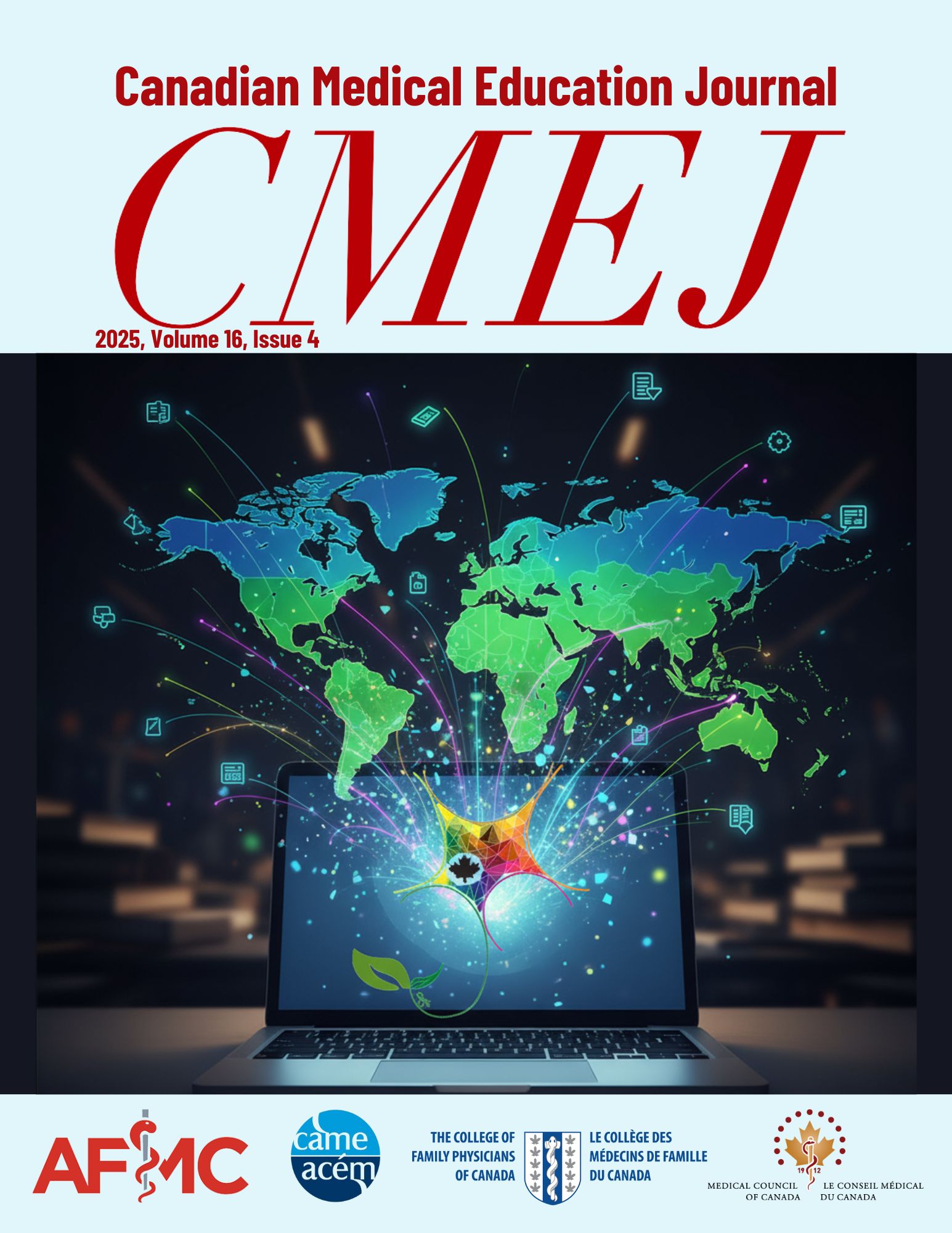Acting as a change agent: longitudinal effects of a tailored training program aimed at developing the competencies of health and social service professionals
DOI:
https://doi.org/10.36834/cmej.80292Abstract
Background: We aimed to describe the immediate and medium-term effects of training in the role of change agent (CA) on: 1) the perceived competence to act as a CA; 2) the acquisition of skills required for the role; and 3) the anticipated and actual implementation of CA actions in real-world settings by professionals.
Methods: Using a summative evaluation design and a self-administered online questionnaire, we collected data at three time points: before the training, immediately after, and six months later. We analyzed the data using descriptive and inferential statistics.
Results: The 39 participants, aged 25 to 44, were mostly women. For both perceived competence to act as a CA and the acquisition of the required skills, the proportion of professionals responding positively increased significantly immediately after the training and decreased six months later. Although professionals intended to act as CAs right after the training, their actions had not materialized within the following six months.
Conclusion: Support measures may help sustain the effects of the training in the medium term and encourage real-world implementation of change agent actions.
Downloads
References
1. Meharg S. Critical change agent characteristics and competencies for ensuring systemic climate adaptation interventions. Sustainabil Sci. 2022;18(3):1445-1457. https://doi.org/10.1007/s11625-022-01250-8
2. Picotin J, Beaudoin M, Hélie SS, Martin A-√â, Carrier A. Occupational Therapists as social change agents: exploring factors that influence their actions. Can J Occup Ther. 2021;88(3):231-243. https://doi:10.1177/00084174211022891
3. McDermott C, Shank K, Shervinskie C, Gonzalo JD. Developing a professional identity as a change agent early in medical school: the students' voice. J Gen Med. 2019;34(5):750-753. https://doi:10.1007/s11606-019-04873-3
4. Taylor JD, Bruno D. Training health professional students as social risk advocates. pedagogy in health promotion. 2024;10(4):215-221. 48 https://doi:10.1177/23733799241258448
5. Carrier A, Ethier A, Beaudoin M, et al. Agentivité : perspectives des ergothérapeutes quant à leur sentiment de compétence et leurs compétences à la suite d’une formation. Revue canadienne de l’éducation médicale. 2024;15(4): 15-27. https://doi:10.36834/cmej.78346
6. Martin JS, Mccormack B, Fitzsimons D, Spirig R. Evaluation of a clinical leadership programme for nurse leaders. J Nursing Manag. 2012;20(1):72-80. https://doi:10.1111/j.1365-2834.2011.01271.x
7. Brousselle A, Champagne F, Contandriopoulos AP, Hartz Z. L’évaluation : concepts et méthodes. Montréal, Canada : Les Presses de l’Université de Montréal; 2009.
8. O'Connell J, Gardner G, Coyer F. Beyond competencies: using a capability framework in developing practice standards for advanced practice nursing. J advanced nursing. 2014;70(12):2728-35. https://doi.org/10.1111/jan.12475
9. Sandi Mann. What should training evaluations evaluate? J Euro Indust Train. 1996;20(9):14. https://www.emerald.com/insight/content/doi/10.1108/03090599610150264/full/pdf?casa_token=RMQf2XBaug4AAAAA:BI5Mx_7mdlzBriiLByKZzBjnDQuGWQKTbQ4h0VpQm6dBfTk6rOuT7l6bqYoDJ_l8Qu-aHxzcIzCMK6tsBXPerfAbgZTlR8D2kt3065HsYW5Al68c9aw [Accessed on 12 juin 2025]
10. Carrier A. «Performance» et pratique professionnelle dans les services de soutien à domicile offerts aux aînés: effets et actions possibles pour assurer un développement durable. Phronesis, 2021;10(4):156-178. https://doi.org/10.7202/1083982ar
11. Dillman DA, Smyth JD, Christian LM. Internet, phone, mail, and mixed-mode surveys: the tailored design method. 4th Ed. New Jersey: Wiley; 2014.
12. Lavoie-Trudeau √â, Beaudoin M, Carrier A. L’évaluation des compétences d’agent de changement des professionnels de la santé et des services sociaux : développement d’un questionnaire auto-administré à l’aide de la méthode Delphi. Mesure et Évaluation en Éducation. 2023;46(2): 101-127. https://doi.org/10.7202/1111100ar
13. Rufibach K. Assessment of paired binary data. Skeletal Radiology. 2011;40(1):1-4. https://doi.org/10.1007/s00256-010-1006-1
14. Howell DC. Statistical methods for psychology. 7th ed. California: Wadsworth Cengage Learning ; 2010.
15. Lin CJ, Chang PR, Wang LH, Huang MC. Cultural competence course for nursing students in Taiwan: a longitudinal study. Nurse Educ Today. 2015;35(12):1268-1274. https://doi:10.1016/j.nedt.2015.05.023
16. Hatfield TG, Withers TM, Greaves CJ. Systematic review of the effect of training interventions on the skills of health professionals in promoting health behaviour, with meta-analysis of subsequent effects on patient health behaviours. BMC Health Serv Res. 2020;20(1). https://doi:10.1186/s12913-020-05420-1
17. Blondin-Nadeau P, Audet J, Chenard √â, et al. Synthèse des facteurs internes essentiels aux ergothérapeutes pour agir en tant qu'agent de changement. Revue francophone de recherche en ergothérapie. 2021;7(1) : 33-53. https://doi.org/10.13096/rfre.v7n1.180
18. Jonnaert P, Masciotra D, Barrette J, Morel D, Mane Y. From competence in the curriculum to competence in action. prospects Prospects. 37, 187–203 2007. https://doi.org/10.1007/s11125-007-9027-9
19. Reeve J. Psychologie de la motivation et des émotions. 2e édition revue et augmentée. De Boeck Supérieur; 2017.
20. Valiquette C, Houde LM, Chamberland-Deschênes K, et al. Synthèse des facteurs externes qui influencent la capacité des ergothérapeutes à agir en tant qu’agents de changement. Revue francophone de recherche en ergothérapie. 2022;8(2):109-130. https://www.rfre.org/article/view/5037/4491
Published
How to Cite
Issue
Section
License
Copyright (c) 2025 Annie Carrier, Michaël Beaudoin, Alexandra Ethier, Denis Bédard

This work is licensed under a Creative Commons Attribution-NonCommercial-NoDerivatives 4.0 International License.
Submission of an original manuscript to the Canadian Medical Education Journal will be taken to mean that it represents original work not previously published, that it is not being considered elsewhere for publication. If accepted for publication, it will be published online and it will not be published elsewhere in the same form, for commercial purposes, in any language, without the consent of the publisher.
Authors who publish in the Canadian Medical Education Journal agree to release their articles under the Creative Commons Attribution-Noncommercial-No Derivative Works 4.0 Canada Licence. This licence allows anyone to copy and distribute the article for non-commercial purposes provided that appropriate attribution is given. For details of the rights an author grants users of their work, please see the licence summary and the full licence.










